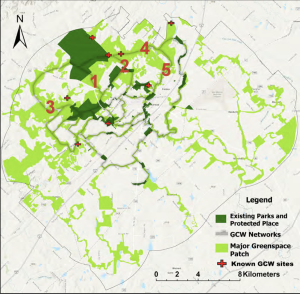 Where are the wildlife corridors in San Marcos? Obviously, the Greenbelt serves that purpose, but our natural areas aren’t enough. What about additional areas of the city that birds and other animals might need for food and shelter? How connected are these habitable spaces?
Where are the wildlife corridors in San Marcos? Obviously, the Greenbelt serves that purpose, but our natural areas aren’t enough. What about additional areas of the city that birds and other animals might need for food and shelter? How connected are these habitable spaces?
This is the question that Texas State geography graduate student Raihan Jamil proposed when he applied for an SMGA Fellowship in 2020. Since receiving that grant of $2000, he has been working with geography faculty and SMGA members Jason Julian and Kimberly Meitzen to find where these wildlife corridors are, especially for the golden-cheeked warbler and Rio Grande turkey. Their findings recently appeared in Land, a peer-reviewed journal published by MDPI (Multidisciplinary Digital Publishing Institute). A link to a PDF of the entire article appears at the end of the abstract below.
– Editor
Urban Green Infrastructure Connectivity: The Role of Private Semi-Natural Areas
Raihan Jamil, Jason P. Julian * , Jennifer L. R. Jensen and Kimberly Meitzen
Abstract: Green spaces and blue spaces in cities provide a wealth of benefits to the urban social–ecological system. Unfortunately, urban development fragments natural habitats, reducing connectivity and biodiversity. Urban green–blue infrastructure (UGI) networks can mitigate these effects by providing ecological corridors that enhance habitat connectivity. This study examined UGI connectivity for two indicator species in a rapidly developing city in the southern United States. We mapped and analyzed UGI at a high resolution (0.6 m) across the entire city, with a focus on semi-natural areas in private land and residential neighborhoods. Integrating graph theory and a gravity model, we assessed structural UGI networks and ranked them based on their ability to support functional connectivity. Most of the potential habitat corridors we mapped in this project traversed private lands, including 58% of the priority habitat for the Golden-cheeked Warbler and 69% of the priority habitat for the Rio Grande Wild Turkey. Riparian zones and other areas with dense tree cover were critical linkages in these habitat corridors. Our findings illustrate the important role that private semi-natural areas play in UGI, habitat connectivity, and essential ecosystem services.
[gdlr_button href=”https://smgreenbelt.org/wp-content/uploads/2024/10/Jamil-2024UGI_connectivity.pdf” target=”_self” size=”medium” background=”#455447″ color=”#ffffff”]View Article[/gdlr_button]
